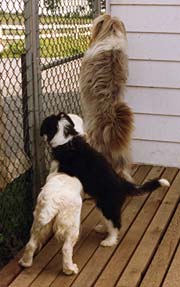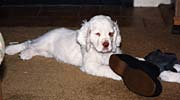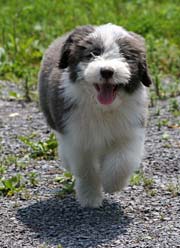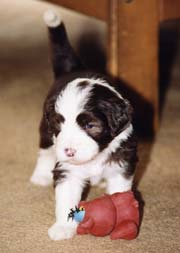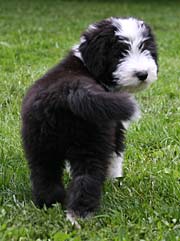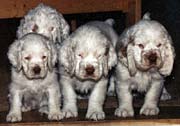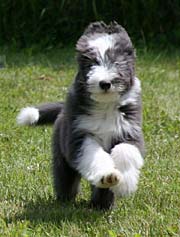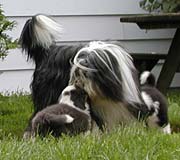|
Trading objects is a great game to play with a puppy, a game that brings great benefits when the dog is an adult. Teaching a pup that giving up an object brings praise and treats will prevent possessiveness, and could in fact save his life if he happens to get into something dangerous and you need to take it away, quickly! Don’t wait until the puppy has something he shouldn’t have, start with his own toys. Offer a cookie in exchange for the toy, praise for the puppy giving up the toy and taking the cookie, and sometimes (but not always) give the toy back, or give the pup another toy. If the pup is caught chewing on something he shouldn’t, just calmly take it away and give the pup something he is allowed to have instead, praising him for chewing what you give him. Remember that puppies, like human babies, explore the world with their mouths, and there’s a lot to explore for a new puppy!
Growling and possessiveness happen when a dog has something, doesn’t want to give it up, and thinks someone is going to take it. It’s a natural behaviour for a dog. When this behaviour occurs, often ‘trainers’ will recommend getting angry and confronting the dog, forcibly removing the object, and then scolding the dog. But what does this teach? Now the dog is going to guard his object even more fiercely because the owner didn’t heed his warnings the first time, and what’s more, he got punished! If the dog later happens to get a hold of something he’s not supposed to have, he sees the owner coming, knows the owner will be angry (though he’s probably not sure why,) growls louder, and takes off running. A chase ensues as the owner races after the dog to retrieve the object; the dog first might think this is a fun new game but as the owner begins to sound more and more angry the dog is sure he doesn’t want to be anywhere near him, so he keeps his distance, dancing just out of reach. The dog is confused, the owner is angry, and whatever the dog has is probably destroyed by now. What a mess, and it all could have been avoided. By teaching a pup that GOOD things happen when he gives up an object, he won’t have to worry about guarding it. It’s no big deal. So if he gets a hold of something he shouldn’t have, you can walk over or call the dog to you, calmly ask him to give it to you, and he’ll happily comply because he knows this means he’ll get praise, a treat, or an even better toy. What fun!
The same concept can be used with feeding – instead of the dog feeling he has to guard his food from the horrible people who might take it from him, you can drop extra little treats on his food while he’s eating so he’ll learn to associate people being near his food dish with extra yummies! Teaching a dog not to be possessive of toys or food is particularly important in families with young children, since often they are the ones that end up being bitten when they simply want to go hug the dog while he’s chewing a bone or eating his food. Although I do recommend teaching children to be cautious in such situations regardless of how well trained the dog is, children will be children and it’s better to know that if they do go ahead and do something like this, the dog has been taught to react calmly and won’t lash out.
There is an awful lot to teach a puppy, from basic manners, guidelines, what not to chew, and where to pee, to walking on leash and basic obedience. It is my firm belief that ALL of these things can and should be taught using positive methods, simply channelling a pup’s natural enthusiasm into the desired behaviours rather than correcting everything other than the ‘right’ behaviour. Keep learning fun, first and foremost! Teach the puppy through praise and rewards, forming a trusting and respectful bond between owner and dog, and using as little physical force as is necessary. Force begets force, and aggression begets aggression – push down on a dog and he’ll almost certainly push back up. Treat a dog harshly and he will respond harshly. Fear should have no place in training, and the “do as I say because I said so” mentality where the owner is boss and the dog better behave or he’ll get physically corrected is an outdated and sad concept, that unfortunately does still linger in many circles today. If you are choosing a training class and this is how it’s taught, go elsewhere!
Each dog is different, and sometimes what works with one dog won’t work with another. A trainer should be flexible and be willing to modify their methods to suit the dog, taking into account the wishes of the owner. Traditional trainers often roll their eyes if a ‘silly’ Beardie bounces into class exuberantly, considering them furry airheads, which they most certainly are not. Instead of being pleased that here is a happy dog who enjoys the world, and with a little effort can have that enthusiasm channelled into becoming a well behaved pet, they groan at the ‘out of control’ dog and proceed to try and quite literally whip it into shape. True, Beardies might be a bit more to handle than that placid Golden or shy Sheltie, and most do not respond as well to those traditional jerk and pull methods, but this should be an indication that Beardies are smarter than the average dog!
Fortunately more and more trainers are adopting more positive methods, particularly clicker training. Beardies are a sensitive, happy, smart and enthusiastic breed that does wonderfully when treated fairly and positively. They will never be ‘robot’ dogs, but they’ll keep you smiling at their intelligence, enthusiasm and ingenuity, and I’d rather have that than a dog that sits perfectly straight and goes through obedience routines without a whit of personality!
In training basic things, such as leash training, think about it from the pup’s point of view. Is the puppy pulling on leash? Why is he doing that? Probably because he’s excited and wants to go forward. Instead of incessantly jerking on the leash to get him to stop pulling (all the while still walking forward,) why not just stop, stand still, and wait for the pup to realize he isn’t going forward anymore. Chances are he’ll sit or turn around and wonder why the heck he’s not getting anywhere, and ta daa the leash is loose and you can go forward again. So he darts out to the end of the leash again? Then just repeat the sequence. Puppy pulls, you stop, puppy stops pulling, you go forward. It won’t take long for the puppy to realize that to get what he wants (going forward) the leash has to be loose, and he’ll stop pulling. The puppy is learning that his actions control the outcome. For a smart, manipulative breed such as a Beardie, it works wonders!
When a puppy isn’t behaving how you want him to, try to think about WHY the puppy is doing something. Think of what he is getting out of it, and use this to figure out how to stop the behaviour. Is he digging in your flowerbeds? Well, digging is fun, and is a normal dog behaviour. Instead of constantly punishing him for it, why not create a spot in the yard where the dog CAN dig and encourage him to use that area and not your prized petunias.
One other thing to mention in training a puppy is teaching bite inhibition. All dogs will use their mouths, and mouths have teeth, sharp ones in puppy mouths! Puppies chew everything – toys, shoes, fingers, you name it. It’s how they explore and how they play. One of the most important things an owner can teach a puppy is just how strong that mouth is. At some point in a dog’s life there may come a time when he feels scared, sick, or threatened enough to lash out and bite. A dog who knows the power of his mouth and the damage it can do will use only enough pressure to get his point across. Most dogs don’t want to inflict pain or cause injury when they bite; they just want the person to go away. The damage results because they just weren’t aware of their own strength, and they bit too hard. Often these dogs were taught from early on never to use their mouth on a person. Even gentle mouthing was reprimanded, and the dog, as a result, never learned control.
Think of a human toddler, grabbing everything in his hands as hard as he can. Parents carefully teach the child ‘gentle’ when he touches an animal, for instance, because grabbing hard can cause pain. Now think of that child all grown up had he never been taught to be gentle, and instead was taught never to touch anything. He picks up a china vase and it breaks to pieces in his hands; he hugs a friend and leaves bruises. For a dog it’s all about his mouth, and it’s up to his owners to teach that mouth to be gentle.
More info with links to other good sites can be found on our Training page.
Continued on:
Socialization
Back to:
Raising Your New Puppy







